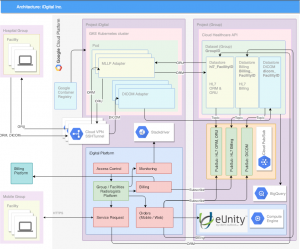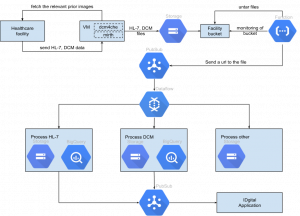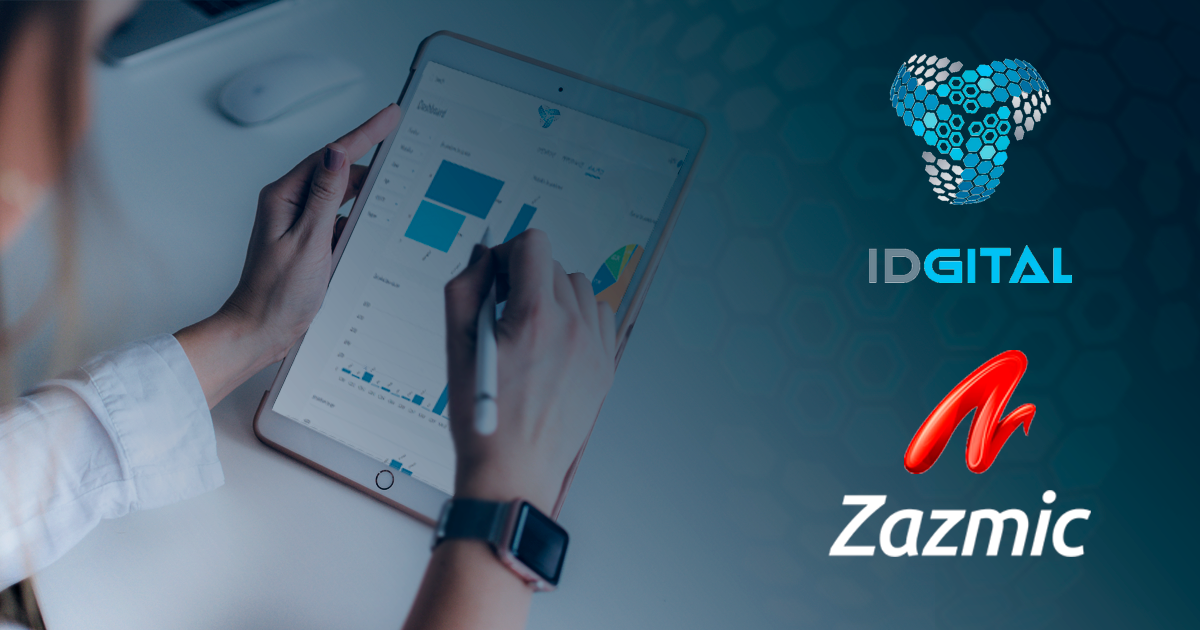The Digital Assistance Platform (DAP) released by IDGITAL this year offers a zero footprint, end-to-end radiology solution. This platform was designed by practicing radiologists and radiology professionals with proven market leadership. IDGITAL is the only full-stack diagnostic radiology Machine Learning (ML) platform in the world. Working alongside Zazmic and using its expertise in Google Cloud services, the proprietary diagnostic radiology cloud-based Digital Assistant Platform was born. The platform is fully integrated with Google’s Artificial Intelligence (Al) and Machine Learning (ML) technologies.
The Big Idea and Zazmic’s Role
IDGITAL’s request was to build a truly next-generation radiology platform that would leverage modern web application and image streaming technology to provide an end-to-end, zero-footprint solution that would resolve many of the technological limitations of the legacy technologies available in the market today. Through a truly cloud-based architecture, IDGITAL’s goal was to decrease transmission time required to get the patient’s radiology exam in front of the appropriate clinical specialist, while allowing for seamless integration of advanced computing techniques such as artificial intelligence and machine learning with the goal of providing better patient outcomes by significantly reducing the time required to diagnose emergent health conditions. By creating a multi-tenant, zero-footprint solution, IDGITAL’s Digital Assistant Platform would allow for consultation across multiple radiology practices across town or across the world. A system that truly links experts in the field, anywhere in the world, via a simple internet connection.
IDGITAL was formed by radiologists and radiology operational experts with decades of proven success in the practice management space, having run some of the largest practices in the country. The end-user client for IDGITAL’s Digital Assistant Platform would be radiology practices based in the critical care hospital market as well as federal rural health initiatives, Imaging Centers, Urgent Care Centers, and large physician practices.
While IDGITAL had the radiology expertise, Zazmic provided the technical expertise to make the project successful. Zazmic is a global software company that has hundreds of dedicated data scientists and developers who have developed software for some of the world’s top companies Zazmic is also a Premium Google Cloud partner. Because of these factors, IDGITAL saw that Zazmic could offer feature-rich solutions and manage the entire product development lifecycle. Zazmic was the first choice because it also offers clients:
- Custom software for Data Science (ML, Al)
- Web
- Python
- Java
- .Net
- Node
- Angular React-Mobile-iOS & Android
Understanding Clinical Models
Gathering relevant patients’ information is no small feat. Data is often siloed in legacy proprietary systems that often don’t integrate well if at all. A high level of standardization is necessary if the data is to be used accurately. The creation of standardized models is taking place around the world. This uniformity effort is called Detailed Clinical Models (DCM). In the field of radiology, terms that are specific to this practice are numerous. The amount of data is voluminous as well. Modern diagnostic image sets can range in file size from multiple megabytes to multiple gigabytes, depending on the modality and processing techniques employed. These images must be stored and made available to other interested professionals as well as, in some cases, the patient. Some common terms used in the radiology are:
PACS
This acronym stands for Picture Archive and Communication System where standard 2D and 3D images are stored. A digital radiology practice that stores diagnostic images using local servers or a cloud-hosted solution for convenience and the ability to expand their storage.
RIS
The Radiology Information System is a workflow management software that, in conjunction with the facility’s PACS, coordinates order creation and report generation, and serves as a middleware between the facilities imaging department and the facilities EMR (Electronic Medical Records) system.
HL-7
Health Level Seven is a set of standards, definitions, and constructions used to exchange healthcare data between the various software systems within a hospital or imaging practice.
When a patient comes to a facility for a diagnostic imaging study, an order is generated in the facility’s EMR. An HL-7 message is then exchanged between the EMR and RIS, producing an “order” that informs the imaging technologist that the patient is ready for imaging. The RIS generates several HL-7 status messages through the imaging process that then informs the related systems of the patient’s status. One of these messages triggers a “shell” being created in the PACS and prepares the PACS to receive images from the scanning device. The radiologist views the images stored in the PACS and dictates a report into the facility RIS, which then sends the report via HL-7 back to the EMR.
Speed can be of the essence when a diagnosis is concerned. Many emergent conditions have significantly better patient outcomes when diagnosis and treatment can be delivered in a very short period of time. Minutes can mean the difference between complete patient recovery vs life-long disability or even death. Modern cloud-based technology and advances in image streaming offer a significant leap forward and can have a significant impact on improving patient outcomes in measurable ways.
The IDGITAL project system requirements:
- FDA approved multi-modality diagnostic radiology image viewer
- Maximum uptime with a high speed, scalable solution
- Cloud-based
- Multi-tenant design to allow multiple practices to operate independently
- Use Google’s Healthcare API
- Use with voice assistant
- Use with Firebase to create an application message and process notification

Using GCIoud Tools and BigData Scheme
Zazmic’s use of GCIoud tools was undoubtedly the key to the creation of IDGITAL’s DAP. Zazmic points out some of these tools and explains how important they were to the project.
Healthcare API
Cloud Healthcare API connects the gap between care systems and applications built on Google Cloud. Because Cloud Healthcare API connects healthcare data to advanced Google Cloud capabilities (streaming data processing with Cloud Dataflow, scalable analytics with BigQuery, and machine learning with Cloud Machine Learning Engine) it simplifies app development and device integration to speed-up digital transformation and allows for real-time integration with healthcare networks.
Cloud VPN
Google’s Cloud VPN enlarges enterprises’ peer networks by way of an IPsec VPN tunnel. Traffic becomes encrypted and travels between two networks over the public Internet. It also makes for reliable and easy-to-use Network Interconnection service. Once your offices are connected to all Cloud Services, clients in remote sites can use it and take advantage of secure data transfer.
Clients can utilize DevOps to monitor activity and traffic on the VPN tunnel using StackDriver.
An example of this advantage is that IDGITAL uses Cloud VPN to securely connect hospitals’ infrastructures to the IDGITAL platform.
PubSub
A part of Google Cloud’s data analytics products, Cloud PubSub offers clients flexibility and reliability of enterprise message-oriented “middleware” (multi-purpose software to provide apps not included by the operating system) to the cloud.
Big Data/BigQuery
Google offers a fully managed, petabyte-scale, low-cost analytics data warehouse. There is no infrastructure to manage and no need for a database administrator. This allows clients to focus on analyzing data to find insights that make a difference to their patients. The SQL is familiar and there is a pay-as-you-go model.

Google Cloud Engine (GCE)
An Associate Cloud Engineer deploys applications, monitors operations, and manages enterprise solutions. The person who runs this program is able to also use Google Cloud Console, along with the command-line interface, to perform common platform-based tasks to support one or more deployed solutions that leverage Google-managed and self-managed services on Google Cloud. An individual in the enterprise must receive certification by way of an exam.
Google Compute Engine helps create and run virtual machines on the Google infrastructure. It launches large compute clusters on Google’s infrastructure with ease. Compute Engine supplies performance, scale, and value.
Firebase
Google’s mobile application development platform is called Firebase. Even though Google Cloud Platform (GCP) and Firebase can be used independently from one another, knowing this relationship exists results in significant benefits to developers. Some of these functions include these explanations:
- IT types do not necessarily need to know anything about GCP to begin working with Firebase.
- Google Cloud Console is something like a “container” for code, data, services, and configurations, no matter the creation mode.
- Once you create a Firebase project, you are, at the same time, designing a Google Cloud project “behind the scenes.”
- Firebase projects are managed and viewed in the Cloud console.
- Depending on the project, the Firebase console delegates some frequently occurring tasks, such as administrative user management, or billing management (Identity and Access Management duties) to the Cloud console.
Using Firebase for the IDGITAL Radiology Project
Firebase is the framework by which hospitals around the world can begin to send real-time data to all users of the database. Additionally, Firebase offers:
- Hosting
- Cloud messaging
- Authentication
- Cloud messaging at no cost to users
- Test lab found in the Firebase console
- Focused user notifications
- Crash reporting and avoidance
- Customized emails to all prospective clients
- Powerful links
- App indexing in Google search
Stackdriver
All IT-related ventures must have monitoring systems. When any problems arise, these systems warn users quickly. All Zazmic clients are supported by:
- Scalable and geo-redundant solutions
- Monitoring of all servers
- Micro-services of every application and project
- The Google Stackdriver Monitoring Platform
- Logging
- Error reporting
Zazmic ensures its clients a centralized view over every server and app, no matter the OS or programming language. Whether the server is a Google Cloud Resources product or any bare- metal or virtual server anywhere on the globe, monitoring clients’ data is occurring. Zazmic also has cross-platform agents and Stackdriver capacities worldwide.
Google Cloud – Stackdriver Kubernetes Monitoring
Google created Kubernetes and released it as open-source in 2014. This product provides automated container orchestration and well-tuned machine management to improve users’ time and resources when collaborating between development and operations staff. Jez Humble, author of The DevOps Handbook said DevOps is:
“a cross-disciplinary community of practice dedicated to the study of building, evolving and operating rapidly-changing resilient systems at scale.”
Zazmic engineers used Kubernetes technology to provide “unlimited scalability for microservices architecture.” Google Stackdriver offers some modules for microservice monitoring, such as Stackdriver Kubernetes Monitoring. The Kubernetes Monitoring allows for all data about microservices to be stored in docker containers and resource utilization inside pods.
Kubernetes Clusters are sets of machines (nodes) that run containerized apps managed by Kubernetes. A cluster has a minimum of one node along with one master node. This module monitors every Kubernetes Cluster. The monitoring includes obtaining detailed views of every Pod, microservice, and resource allocation within the Cluster.
Kubernetes and the IDGITAL Project
The IDGITAL radiology project needed specific requirements from the Zazmic team, which included:
- 24/7 connection support among the customer data centers
- Google Healthcare API by way of dedicated VPN-tunnels
- Kubernetes Cluster that supported data aggregation and transfer processes from clients to Google Healthcare API
- The monitoring of all infrastructure (network, microservices, service)
The Zazmic/GCIoud Winning Formula
The team at Zazmic used Google to create a SaaS application that did not need downloading to a computer. All the data in the project became stored on Google servers based on:
- The servers’ high reliability
- The servers’ high speed
- The availability of Google’s Stackdriver for monitoring all servers
- The utilization of Web Viewer to observe and adjust images within the application
Zazmic, a global software company, retains over 250 employees. The company is also a Premium Google Cloud Partner. The company’s GCIoud engineers are known for their abilities, professionalism, and expertise. When faced with a complicated, long-term, and overwhelming project, such as IDGITAL’s, this team went above and beyond to ensure that an end-to-end radiology solution platform came to be.
The way Zazmic handled every step along the path and used its exceptional knowledge and capabilities made the IDGITAL executives thankful that they found an organization like Zazmic. IDGITAL’s administrators hailed the streamlined and thoughtful way that the Zazmic team made this idea come to fruition. The project ended, a new professional relationship was born, and IDGITAL had the Digital Assistant Platform it had been looking for at last.


